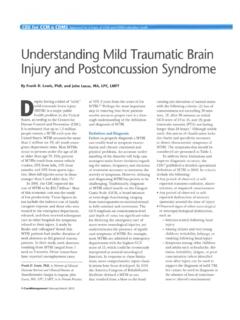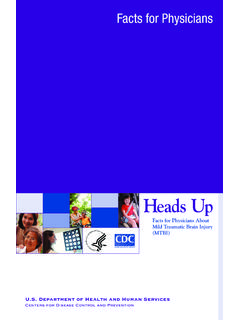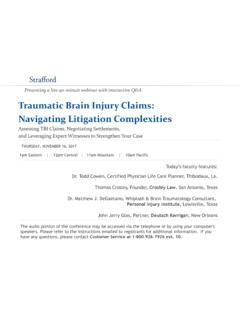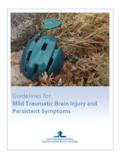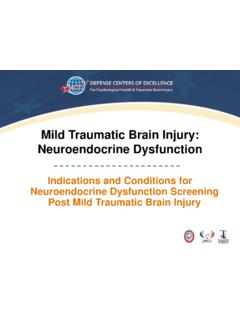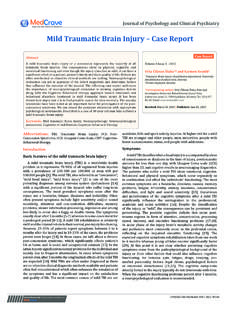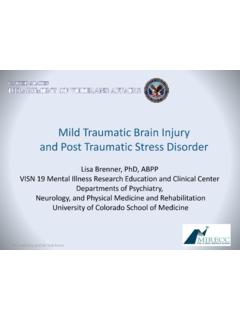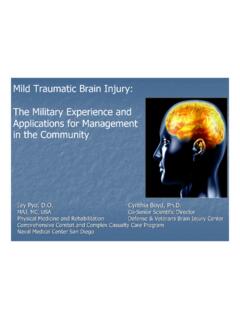Transcription of Case report: Treatment of mild traumatic brain injury with ...
1 UHM 2009, Vol. 36, No. 6 Treatment of mild traumatic brain injury with hyperbaric oxygen391 Case report: Treatment of mild traumatic brain injury with hyperbaric oxygenColonel James K. Wright1, eddie Zant2, Kevin groom3, robert e. sChlegel4, Kirby gilliland41720th Special Tactics Group, Hurlburt Field, Florida, USA; 2 Hyperbaric Medicine Inc., Fort Walton Beach, Florida, USA; 3 The Anchor Clinic, Destin, Florida, USA; 4 Center for the Study of Human Operator Performance, The University of Oklahoma, Norman, Oklahoma, USAAbsTrACTtwo United states air Force airmen were injured in a roadside improvised explosive device (ied) blast in iraq in January 2008. both airmen suffered concussive injuries and developed irritability, sleep disturbances, headaches, memory difficulties and cognitive difficulties as symptoms of mild traumatic brain injury (mTBI). Six months after injury , repeat Automated Neuropsychological Assessment Metrics (ANAM) testing showed deterioration, when compared to pre- injury baseline ANAM assessment, in all measured areas (simple reaction time, procedural reaction time, code substitution learning, code substitution delayed, mathematical processing, and matching to sample).
2 The airmen were treated with hyperbaric oxygen in treatments of 100% oxygen for one hour at atmospheres absolute, resulting in rapid improvement of headaches and sleep disturbances, improvement in all symptoms and resolution of most symptoms. Repeat ANAM testing after completion of the hyperbaric treatments nine months after initial injury showed improvement in all areas, with most measures improving to pre- injury baseline levels. The airmen received no other Treatment besides medical monitoring. Repeat neuropsychologic testing confirmed the improvement. We conclude that the improvement in symptoms and anam performance is most likely attributable to hbo brain injury has been called one of the signature injuries of Operations Enduring Freedom and iraqi Freedom. the rand report documented a 19% self-reported incidence of probable TBI among returning service members, with 320,000 probable TBI cases. Most of these cases (80%) areconsidered mild traumatic brain injury , or mtbi (1).
3 On a per-case basis, one-year costs for mTBI were estimated at $27,259 to $32,759 in 2007 (2). The lifetime costs of even mild TBI impairment in youngservice members can be deeemed incalculable (3). mild tbi is usually characterized by a concussive event that causes a brief period of unconsciousness (lasting less than 30 minutes) or a period of confusion or amnesia lasting less than 24 hours. The Department of Defense has developed criteria for the diagnosis of mTBI, which must include one of the following: 1) any period of loss of or a decreased level of consciousness lasting less than 30 minutes; 2) any loss of memory for events immediately before or after the injury lasting less than 24 hours after the event; 3) any alteration in mental state at the time of the injury such as confusion, disorientation, or slowed thinking lasting less than 24 hours after the event; 4) transient neurological deficits ( , weakness, loss of balance, change in vision, praxis, paresis or plegia, sensory loss, aphasia); and 5) normal intracranial imaging.
4 Findings may be transitory, and late sequelae that are not explainable by other means may qualify an individual for the diagnosis of mTBI. Patients with more than one of these findings may be assigned a higher level of TBI (4).Copyright 2009 Undersea and Hyperbaric Medical Society, 2009, Vol. 36, No. 6 Treatment of mild traumatic brain injury with hyperbaric oxygen392 since the symptoms of mtbi may develop gradually, are often subtle, and can be confused with other illness such as post traumatic stress disorder, mTBI may be unrecognized and undiagnosed (5).a concussive injury causes diffuse axonal injury , structural neuronal damage and diffuse neuronaldysfunction (6). the symptoms of mtbi are variable and may include headache, irritability, impulsivity, anger, cognitive impairment, memory difficulty, loss of executive function, and vestibular and sleep disturbances (7).
5 Electroencephalogram and sleep studies are usually normal. most individuals with mtbi recover in three to 12 months, especially those who are young (8). However, some victims do not recover, or recover slowly; they are at risk for future injury and deterioration of brain function (9). mild tbi usually resolves without Treatment within months, although approximately 20% of patients with mild TBI continue to have lingering symptoms for one year or longer after injury (1,10). Poor scores on neuropsychological testing months after injury have been correlated with poorer outcomes and unresolved symptoms (11). Patients with several post-concussive symptoms are unlikely to improve after one year, in spite of traditional therapy (12). Treatment of mild tbi has included rest and observation, education, cognitive rehabilitation and phamacotherapy (13). Pharmacologic Treatment may be required for control of disabling symptoms of headache, irritability, depression, and anger (14).
6 Because of the efficacy of hyperbaric oxygen (HBO) in treating brain dysfunction from decompression sickness and carbon monoxide injuries, as well as anecdotal reports of its efficacy in treating concussive injuries, we felt HBO might prove of use in treating two airmen injured in a reporT In January 2008 Airman B, a 23-year-old male vehicle operator, was a convoy lead vehicle commander (LVC) sitting in the passenger seat of an M915 14-ton truck. Airman C, a 22-year-old male vehicle operator, was driving the vehicle that was attacked with an improvised explosive device (ied). The detonation occurred on the passenger side of the vehicle, nearer to where airman b was sitting. The vehicle was damaged, and Airmen B and C sustained concussive injuries with a sense of being dazed for several minutes. There was no known direct blow to the head for either occupant or loss of consciousness, although both occupants had tinnitus.
7 Airman b, who was approximately 3 feet closer to the blast, suffered immediately from a severe headache. Airman C continued to drive the damaged vehicle for several minutes and had no immediate symptoms other than being slightly dazed; however, he developed a mild headache some hours later. later in the day, airmen b and C reported to the medical clinic, where no additional injuries were found. They were given acetaminophen for their headaches and placed on light duty. Two weeks later their symptoms had largely resolved, and they were returned to full duty. Three weeks post- injury both airmen noted the return of headaches, with difficulty sleeping. Airman B expressed his headache severity as 5-6 and Airman C as 4-5 (on a scale of 1-10, with 10 being the most severe pain imaginable) with headaches occurring daily and lasting for several hours. Both individuals had difficulty falling and remaining asleep, and they reported sleep duration of three to six hours per night.
8 Additionally both individuals felt they were quick to anger and stayed angry from trivial provocations for several hours. lack of attention to detail, forgetfulness, and fatigue were also reported by both airmen. These latter symptoms began insidiously about three weeks after injury , progressed for about two months and remained constant for the next four months, until Treatment with hbo was administered. Upon arrival at their home base, the airmen presented to the clinic complaining of headaches, fatigue, lapses in memory, irritability and sleep disturbances. Neurological exams were normal, although the airmen appeared tired. Computerized tomography of the brain , EEGs and sleep studies were normal. on initial deployment both airmen had received the Automated Neuropsychological 393 UHM 2009, Vol. 36, No. 6 Treatment of mild traumatic brain injury with hyperbaric oxygenassessment metrics test (anam) on 11 november 2007, two months prior to injury .
9 This test was repeated on 21 July 2008, six months after in-jury. The repeat ANAM testing showed marked declines from the pre- injury baseline in several areas of measurement (Figures 1A and 1B, Page 394). Airman B presented a statistically significant change in Simple Reaction Time and Matching to sample tests, with declines in all other areas. Detailed neuropsychological testing of Airman B at six months post- injury and prior to HBO therapy revealed a diffuse or scattered pattern of deficits. Although his IQ score was within the average range, his neuropsychological functioning on a summary measure (repeatable battery for the Assessment of Neuropsychological Status RBANS Form A) (15) was at just the 7th percentile. moreover, airman b showed marked attention dysfunction for both auditory and visual material; cognitive processing speed was slowed and subjectively observed in casual conversation with the patient.
10 He showed difficulty in repeating sentences and digit sequences as well as learning digit sequences over repeated trials. airman b also demonstrated problems in both verbal learning and visual memory. His reading speed was slowed, fingertip-tapping speed was slowed in both hands, and clerical speed for coding tasks was mildly impaired. He showed difficulty for rhythm perception and visual-motor integration for copying geometric designs. His reaction time was slowed on a computerized measure of attention. Reading level for sight words remained at the college level, but written arithmetic was at just the sixth-grade level. Airman C presented statistically significant and drastic changes in both Simple Reaction Time modules (at the beginning and end of the bat-tery), along with declines in all other areas except Mathematical Processing. Detailed neuropsychological testing of Airman C at the same time prior to HBO therapy was largely within normal limits notwithstanding problems for inconsistent attention and upper-right extremity dysfunction for grip strength and somatomotor integration.
